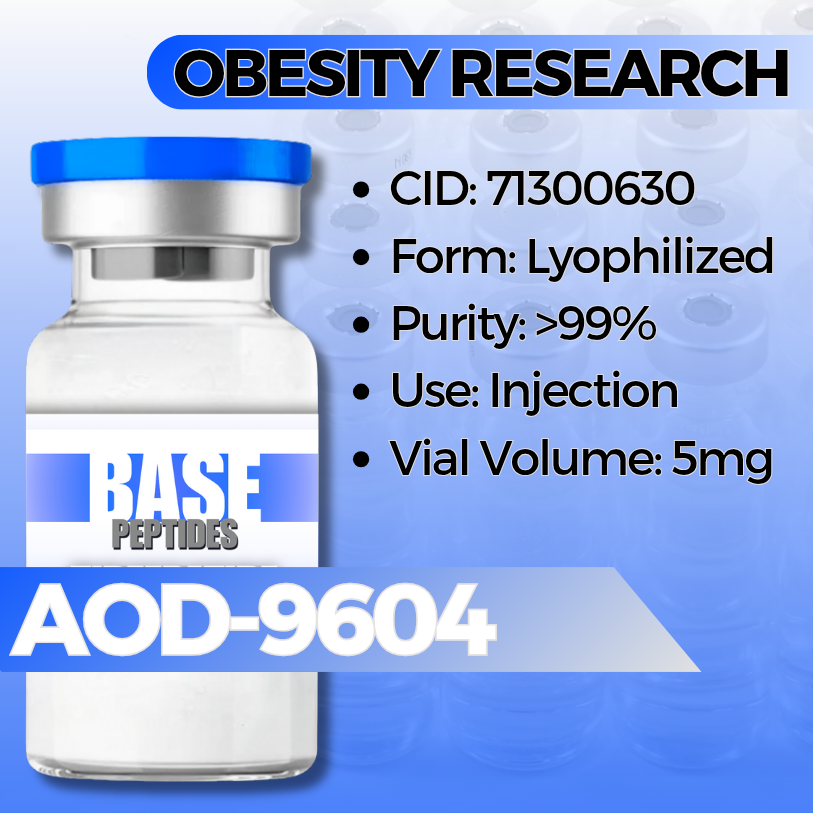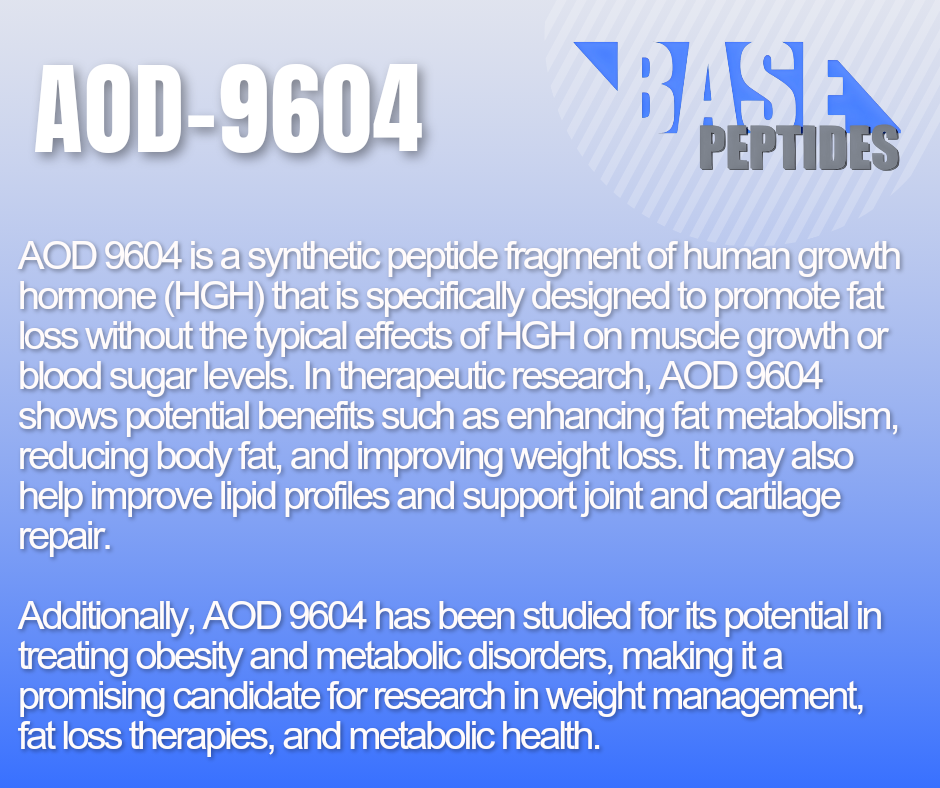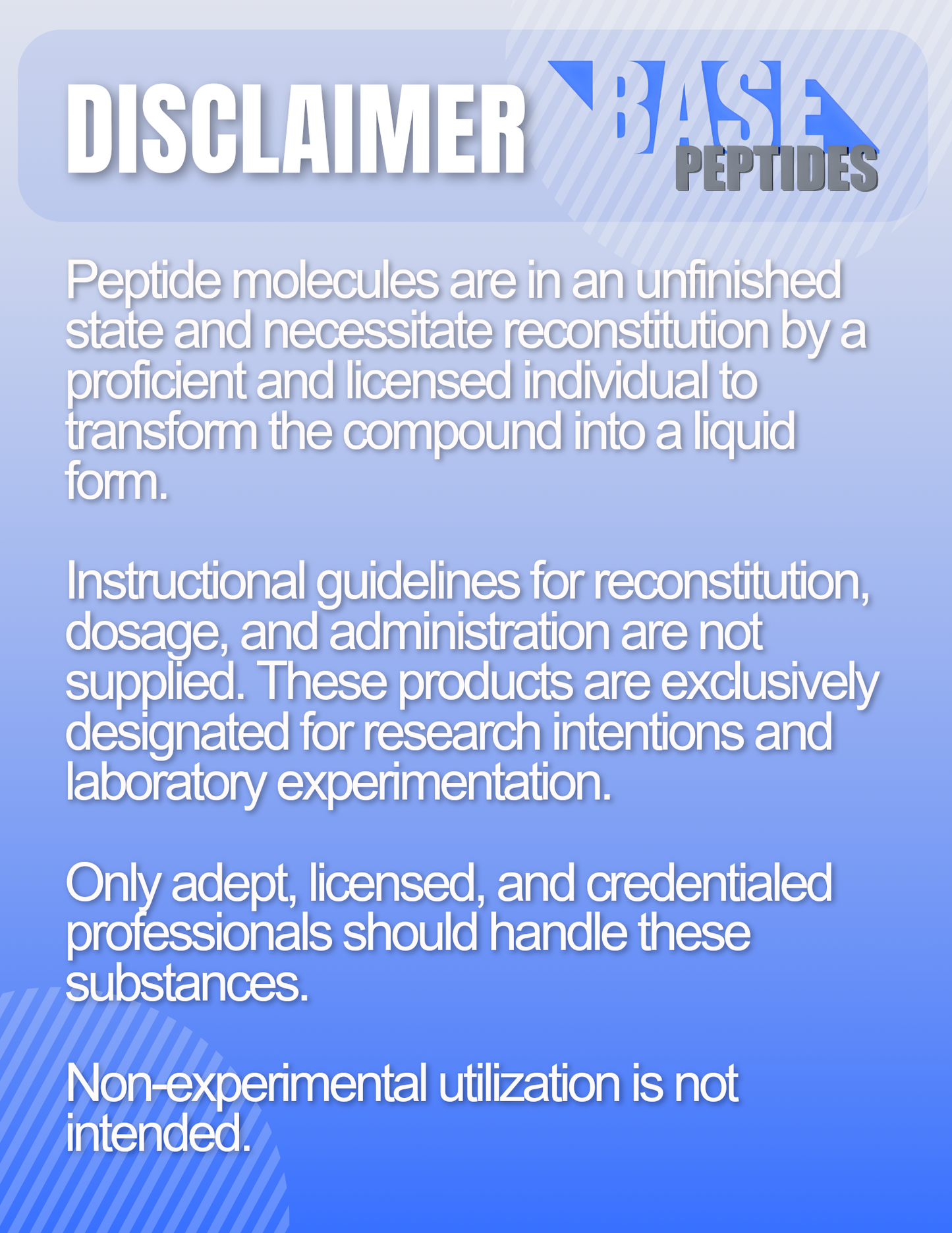AOD-9604
AOD-9604
Base Peptides are intended for licensed medical professionals and experienced researchers. Reconstitution required. Dosing and use instructions are not provided.
Couldn't load pickup availability
AOD-9604 — hGH Fragment (176–191) Analogue
AOD-9604 is a research peptide based on the 176–191 fragment of human growth hormone (hGH), with a stabilizing tyrosine added at the N-terminus. It’s used to explore fat-metabolism signaling in models that examine lipolysis, adipocyte biology, and energy balance—without directly using full-length hGH.
- CAS: 221231-10-3
- PubChem CID: 71300630
- Formula / MW: C78H123N23O23S2 · ≈ 1.6 kDa (salt/form varies)
- Core sequence: Tyr-Leu-Arg-Ile-Val-Gln-Cys-Arg-Ser-Val-Glu-Gly-Ser-Cys-Gly-Phe (hGH 176–191 analogue)
- This fragment models the C-terminal lipolytic region of hGH without engaging the full growth-hormone axis.
- In vitro and animal models use it to track changes in fat-cell signaling, fatty-acid release, and pathway genes involved in lipid handling.
- Because it’s a fragment, it’s useful for asking targeted questions about fat metabolism apart from broader hGH effects.
- To study lipolysis and adipocyte-gene responses (e.g., HSL/ATGL pathway markers).
- To compare fragment vs whole-axis signaling models.
- To explore metabolic endpoints alongside incretin or endocrine tools in combination designs.
Key Studies — What Was Tested, What Changed, Why It Matters
In vitro & animal fat-metabolism models
- What was tested: Adipocyte cultures and rodent models assessing fatty-acid release, lipase activity, and lipid-gene expression after AOD-9604 exposure.
- What changed: Signals consistent with increased lipolysis and shifts in adipocyte gene panels were reported in several preclinical setups.
- Why it matters: These models help isolate the fat-handling component of the GH system without the broader effects of full hGH.
Human data context (mixed findings)
- What was tested: Early human studies explored body-fat and metabolic markers under AOD-9604 exposure.
- What changed: Findings were inconsistent for robust fat-loss outcomes in humans.
- Why it matters: For research design, AOD-9604 is best positioned as a mechanistic tool (pathway and biomarker studies), not as a broad efficacy agent.
Plan endpoints accordingly—focus on mechanistic readouts (gene/protein markers, lipolysis assays), not consumer-style outcomes.
Combination and delivery explorations
- What was tested: Pairing the fragment with other metabolic cues (e.g., incretin analogues) or alternative delivery systems in preclinical contexts.
- What changed: Model-dependent shifts in lipid metabolism and mitochondrial readouts; delivery can influence stability and uptake.
- Why it matters: Encourages careful control of vehicle, pH, and timing when comparing single vs combination arms.
Potential Research Applications
Adipocyte & Lipolysis
- Hormone-sensitive lipase (HSL) / ATGL activity assays
- Glycerol/FFA release and lipid-droplet imaging
Metabolic Signaling
- Gene panels for lipid handling (PPAR, CPT, UCPs)
- Mitochondrial markers and energy-use readouts
Comparative Models
- Fragment vs whole-axis peptide comparison
- Add-on studies with incretin or endocrine tools
Synergistic Peptides (for Study Design)
Semaglutide (GLP-1)
- Why pair: Incretin pathway for appetite/glucose control; complements lipid-handling studies.
- Angle: Appetite + lipolysis biomarkers under combined stimuli.
Tirzepatide (GLP-1 + GIP)
- Why pair: Dual incretin model; allows single vs dual vs fragment comparisons.
- Angle: Glucose curves, lipid panels, and body-composition imaging (where applicable).
CJC-1295 (with DAC)
- Why pair: Probes GH/IGF-1 cross-talk with a long-acting GHRH analogue.
- Angle: Energy-use and lipid markers under endocrine + fragment conditions.
Design Notes
- Separate arms clearly (fragment alone vs combo) and pre-register endpoints.
- Control feeding schedule, ambient temperature, and activity—these shift lipolysis readouts.
- Document formulation (vehicle, pH, light exposure) and storage for reproducibility.
Known Concerns (Context)
- Human efficacy: Broad fat-loss claims are not supported; design studies for mechanism, not outcomes.
- Assay sensitivity: Lipolysis measurements are timing- and temperature-sensitive; standardize rigorously.
- General: Research use only; not for human consumption or therapeutic use.
Follow institutional SOPs for metabolic-pathway peptides and sampling schedules.
Specifications & Handling
- Form: Lyophilized powder (lot-coded)
- Purity: ≥ 99% (HPLC/MS verified)
- Storage: ≤ −20 °C; protect from light/moisture
- In solution: Aliquot promptly; avoid repeat freeze–thaw
- Additives: None unless specified per lot
- Packaging: Tamper-evident; research-only labeling
Regulatory & Use Notice
Sold for laboratory research use only. Not for human consumption, medical, or veterinary use. No human-use instructions are provided. Buyer is responsible for safe handling and regulatory compliance.
AOD-9604 Peptide Research | hGH Fragment 176–191 Analogue | Lipolysis & Adipocyte Signaling






